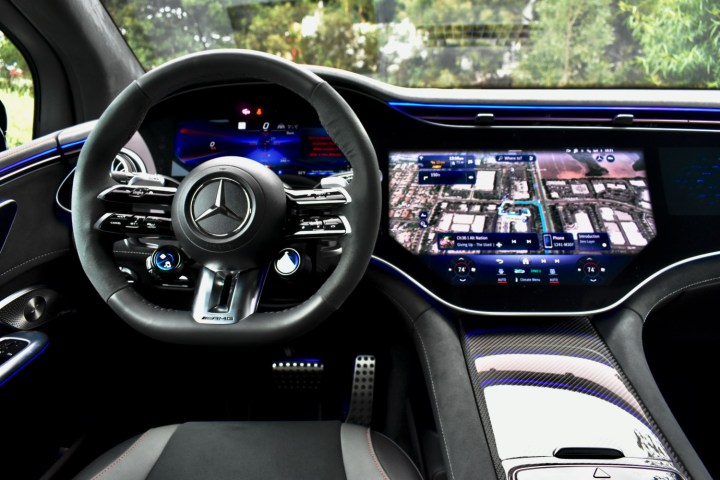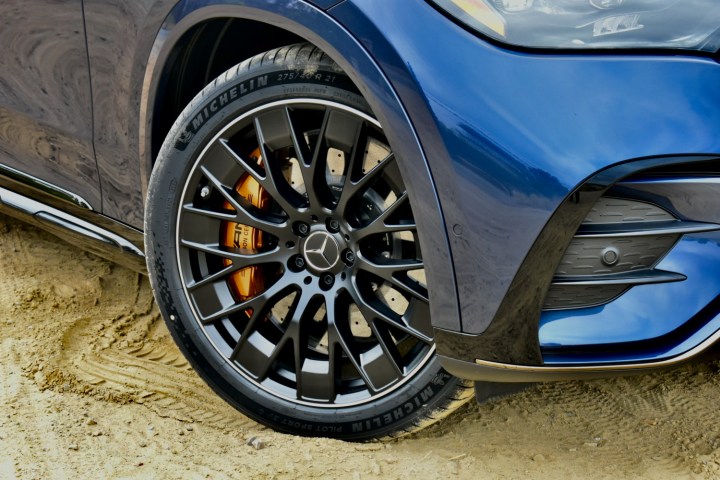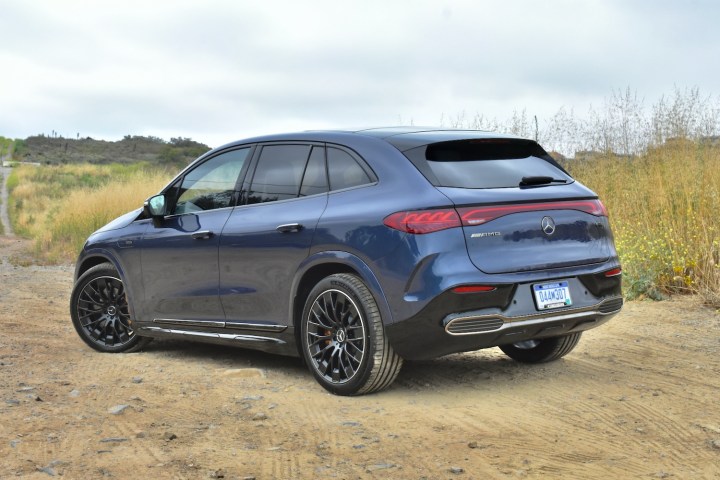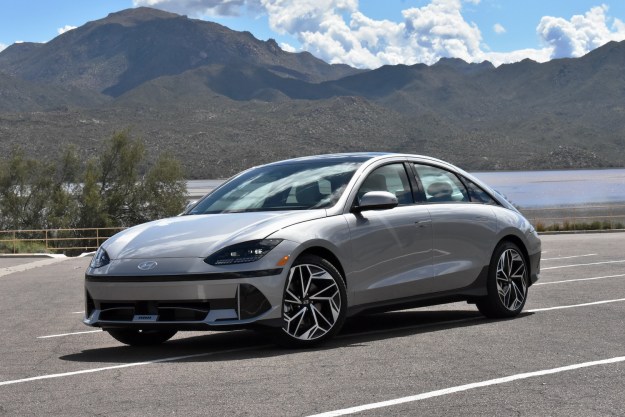
With EV production ramping up, automakers can now shift attention to something more fun: making EVs that are engaging to drive, the kind that encourage you to take the long way home. Mercedes-Benz is putting its best people on the job.
For more than 50 years, AMG has been turning Mercedes luxury cars into race cars and hot rods—and the performance division is now working its magic on EVs. We’ve already gotten AMG versions of the Mercedes-Benz EQS and EQE sedans, but AMG is now upping the difficulty level with an electric SUV.
The 2024 Mercedes-AMG EQE SUV is AMG’s take on the EQE SUV that launched earlier this year. In addition to finding a substitute for more visceral internal-combustion engines, AMG had to contend with a higher center of gravity and even more weight to make this SUV truly sporty. With so many electric SUVs on the market, the AMG EQE SUV could go down as a mere trial run, or be a harbinger of endless boringness to come.
Design and interior

AMG models have never been flashy. Except for subtle changes noticeable only to sharp-eyed car enthusiasts, they generally look like the Mercedes vehicles they’re based on. That stealth look is part of the fun, and AMG hasn’t changed it for the electric models.
The AMG variant looks like an EQE SUV that’s ready for a job interview. Everything is pretty much the same, just sharper and more put together. The black panel meant to suggest a grille has sprouted some vertical bars like the ones you’d see on a gasoline AMG model, the wheels have a sportier design, and the front and rear fasciae get some subtle aerodynamic additions.
The AMG variant looks like an EQE SUV that’s ready for a job interview.
The overall shape is still the same, however. Mercedes rounded off the edges of traditional SUV design in the same of reducing aerodynamic drag, which is an important factor in maximizing EV range. It doesn’t make the EQE SUV especially pleasant to look at, though, although at least it will be easier to tell the AMG EQE SUV apart from the larger EQS SUV, which doesn’t get the AMG treatment.
The interior also largely carries over from the base EQE SUV, but in this case, that’s a good thing. Mercedes has come up with an interior design theme that’s both modern and luxurious. And while this is a performance vehicle, you still get plenty of creature comforts, including leather seats that are plenty comfortable for long highway drives.
Tech, infotainment, and driver assist

The AMG EQE SUV gets the Hyperscreen display previously seen on other Mercedes EQ models, consisting of a digital instrument cluster, central touchscreen, and a front-passenger touchscreen under one dashboard-spanning piece of glass. The displays span 56 inches in total, although the three screens operate independently. Wireless Apple CarPlay and Android Auto are included as well.
Also present is the familiar Mercedes-Benz User Experience (MBUX) infotainment system, which provides a similar experience to other recent Mercedes models. The main touchscreen, which has a “Zero Layer” concept that overlays key functions as tiles on a map display, is easy to navigate. Or you could just use the very reliable voice recognition system, which remains the gold standard for such tech in cars.
You can put the various screens to work analyzing the car’s performance.
In this AMG model, you can also put the various screens to work analyzing the car’s performance. The instrument cluster can show a G-meter, so you can see exactly how close you are to making your passengers vomit. Any passenger with a strong stomach can monitor the flow of energy between the two electric motors, or use a virtual IWC stopwatch to time the driver.
Going for the AMG model doesn’t mean sacrificing driver-assist tech. The AMG EQE SUV includes expected features like adaptive cruise control and automatic emergency braking, as well as a traffic-jam assist function that allows it to creep forward in stop-and-go traffic. Aside from a lane-change assist function that seemed to have a mind of its own, executing lane changes unprompted, everything performed as expected.
Driving experience

AMG puts most of its effort into the suspension and powertrain. In the AMG EQE SUV, that means one electric motor driving each axle, with a combined output of 617 horsepower and 701 pound-feet of torque, compared to 402 hp and 633 lb-ft for the most powerful dual-motor, non-AMG version of the EQE SUV.
Output can be further boosted with a Race Start mode, which temporarily provides 677 hp and 738 lb-ft of torque for quick getaways. With Race Start mode engaged, Mercedes estimates the AMG EQE SUV will do zero to 60 mph in 3.4 seconds, compared to 4.6 seconds for the quickest non-AMG model. Top speed also increased from 130 mph to 149 mph, while the battery pack has the same 90.6-kilowatt-hour capacity as other EQE SUV models.
Instead of the familiar roar of an engine, you get what sounds like the moaning of a depressed robot.
Other upgrades include an AMG-specific air suspension system with adaptive dampers, standard rear-axle steering, and an electromechanical anti-roll system that automatically adjusts to smooth out bumps or tauten the chassis for sharper handling, as needed. Upgraded brakes and a selection of drive modes (Slippery, Comfort, Sport, Sport+, and an Individual mode that lets you mix and match settings), along with an artificial soundtrack meant to take the place of engine noises. Instead of the familiar roar of an engine, you get what sounds like the moaning of a depressed robot.
Bizarre noises aside (they can be turned off), the AMG EQE SUV was definitely an improvement over the base version. Quick acceleration enabled by instantly available torque is now an EV cliché, but in this AMG EV you can really feel the accelerative force. The AMG model also felt more composed in corners, without sacrificing the standard version’s plush ride.
Yet while this is definitely a better EQE SUV, it’s not the most fun EV to drive. On narrow roads — like the kind Mercedes sent us on for part of the test drive — the vehicle’s width and the lack of precision from the steering wheel will have you nervously eyeing the lane markers. And while the AMG EQE SUV can get itself around corners with impressive efficiency, it’s very much a point-and-shoot car where the driver is mostly along for the ride.
It may not be totally in line with the AMG ethos, but the AMG EQE SUV is much better at blasting down highways than attacking twisty roads. It’s as comfortable as you would expect a Mercedes to be, and you can put the added power to good use overtaking semi-trucks.
Range, charging, and safety

Mercedes hasn’t released range estimates for the AMG EQE SUV, but this more powerful performance model is unlikely to beat the non-AMG versions. Official ratings haven’t been published for those models either, although Mercedes doesn’t expect any of them to surpass 300 miles.
Like other EQE SUV models, the AMG EQE SUV can DC fast charge at up to 170 kilowatts, which should be good for a 10% to 80% charge in under 40 minutes. That, along with the quoted Level 2 AC power rate of 9.6 kw, isn’t game-changing. Mercedes owners will at least soon have access to a network of dedicated charging stations, which the automaker claims will provide a better experience than the third-party stations it currently relies on.
The Insurance Institute for Highway Safety (IIHS) and National Highway Traffic Safety Administration (NHTSA) haven’t published crash-test ratings for the EQE SUV, but if they do the ratings should be applicable to the AMG model. Expect it to get the same warranty coverage as other Mercedes models as well, including a four-year, 50,000-mile, new-vehicle warranty and a 10-year, 155,000-mile, battery warranty.
How DT would configure this car

It may not be the ultimate performance car, but this AMG model is definitely a better EQE SUV. Its extra power and more composed driving dynamics enhance the driving experience, and you still get the same well-designed interior and infotainment system as the standard EQE SUV. So this is definitely the EQE SUV to have, even though it will probably cost substantially more than the standard version, which currently tops out at $96,400.
If you want a sporty luxury EV, though, it might be worth looking at some of the electric sedans currently on offer. The Mercedes EQE sedan is also available in AMG guise, and while it doesn’t have as much interior space as its SUV counterpart, its lower center of gravity and road-skimming driving position make it closer to a true driver’s car. Ditto the ultra-quick Lucid Air and Tesla Model S, as well as the Audi e-tron GT and Porsche Taycan, which leverage chassis tech honed in internal-combustion cars for driving thrills.
Among electric luxury SUVs, the AMG EQE SUV is quicker than the BMW iX M60 and a base Tesla Model X, while Audi hasn’t yet launched an RS performance version of its Q8 e-tron. But more competition is on the way in the form of an all-electric version of the Porsche Cayenne and, potentially, the Lotus Eletre electric SUV that recently launched in Europe. So Mercedes’ biggest achievement with the AMG EQE SUV might just be getting it on sale at the right time.
Editors' Recommendations
- Mercedes’ electric eSprinter isn’t just greener, it’s better
- The Lucid Gravity has more range than any other electric SUV
- Acura’s resurrected ZDX SUV is an EV shortcut
- 2024 Mercedes-AMG S63 E Performance first drive review: high-performance plug-in
- Mercedes-Benz Vision One-Eleven concept looks to the past for inspiration



